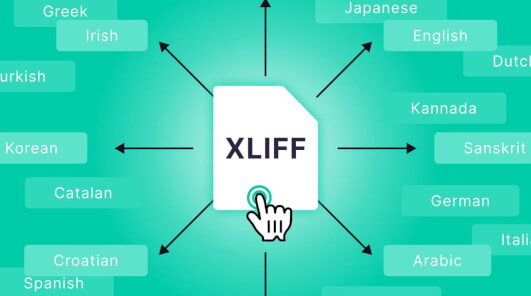One of the leading challenges for learning and development (L&D) teams is how to maximize corporate learning performance and employee engagement for a workforce that speaks multiple languages. Learning in the native language is generally regarded as ideal for optimal understanding and knowledge retention, even for advanced speakers of non-native tongues.
As a result, distributing your corporate learning courses in your organization’s working language may only be achieving limited results. The most effective way to address this issue and optimize employee learning engagement is to offer your e-learning content in employees’ native tongues.
One leading way to level up your corporate learning performance is to translate XLIFF files from your original-language courses. By doing so, you will be able to upload courses in any language, on Articulate 360 Storyline or Rise or any other course-authoring platform. In this article, we explore exactly how to do this in the most efficient, results-focused way! So, let’s dive in.
What is a multi-language XLIFF file?
XLIFF (XML Localization Interchange File Format) is a standard file format that allows for the interchange of data between different translation and localization tools. XLIFF files can accommodate more than one target language but they weren’t designed to do so. While it may seem like a more convenient approach to have one XLIFF file with course content translated into multiple languages, translation industry experts recommend avoiding this approach and sticking with the intended use for XLIFF files: one source language and one target language for optimal translation matching for each additional language.
By doing this, you can translate the same course into multiple languages and thereby have different XLIFF files in each language for the same course. L&D departments are increasingly using XLIFF file localization as an efficient way to distribute content creation in multiple languages, so they can better cater to a global workforce.
What are XLIFF files in multiple languages used for?
A multi-language XLIFF file is primarily used for eLearning translation and corporate course localization. It allows L&D professionals to translate the training courses that they have created into multiple languages, making it easier to distribute to, and resonate with, a multi-language workforce.
This is particularly pertinent if your company operates in multiple countries or regions, as it allows you to provide consistent training and education to all of your employees, regardless of their location or native language.
But it doesn’t have to only apply to countries in more than one country. Firebirds Wood Fired Grill, a restaurant organization with dozens of restaurants across the United States, translated 25 e-learning courses in three months from English to Spanish for their Spanish-native-speaking workforce within the USA.
How to use XLIFF files in multiple languages
Using a multilingual XLIFF file is straightforward, especially with the help of a localization platform that supports XLIFF file translation.
First, you need to export your content in XLIFF format from your authoring tool, such as Articulate. With Smartcat, you can upload this file, select your source and target languages, and let Smartcat AI auto-generate a translation for you.
You can then review and edit this translation using Smartcat's two-column translation editor, including inviting your team to your Smartcat Workspace and/or inviting professional linguists to work on your files and with whom you can collaborate from Smartcat Marketplace.
Once you're satisfied with the translation, you can download your translated XLIFF files and import them back into your authoring tool. It’s that simple. In as many languages as you need.
Can I import multilingual XLIFF files to Articulate?
To translate your Articulate courses into multiple languages, you have to duplicate each course for each language and then export the corresponding XLIFF file. For instance, if you had five target languages, you would have to export your files into five different versions, one for each of the five target tongues.
The import process works in the same way, with you having to import each of the translated files to Articulate after having downloaded from your translation platform.
How to create and export XLIFF files in multiple languages with Smartcat
Creating and exporting XLIFF files in numerous languages on Smartcat is a simple, fast process.
First, you need to upload your course content in the source language to Smartcat. Then, you can use the platform's AI to translate your content into your desired languages. Once the translation is complete, you can download your translated XLIFF files and import them back into your course-authoring tool.
Smartcat's AI sourcing feature allows you to quickly find best-match linguists from a marketplace of over 500,000 vendors and 5,000 boutique agencies, based on the vendor’s work experience, client reviews, language pairs, and monetary rates. All this information is visible to you on Smartcat Marketplace, including the vendor’s identity.
You can also speak with linguists directly via Smartcat’s chat feature.
This helps ensure that your e-learning course translations are of the highest quality and meet the expectations of your audience. Plus, Smartcat's AI-driven translation memories learn from every translation, meaning that with each new translation, your AI translation quality and consistency improve. Before long, they typically reach 95%+ accuracy, including on-brand terminology, tone of voice, style, and phrase preferences.
Mastering XLIFF file translation is not nearly as complicated as it may seem from the outset. With Smartcat, it is fast, straightforward, and positions you to reach your entire workforce in an optimal way, helping improve their learning experience and engagement levels.
Need help translating out XLIFF files? Let us show you!
Sign up to get a personalized demo here
✔️Get 15,000 free AI translation words
✔️Cancel at any time
Subscribe to our newsletter


